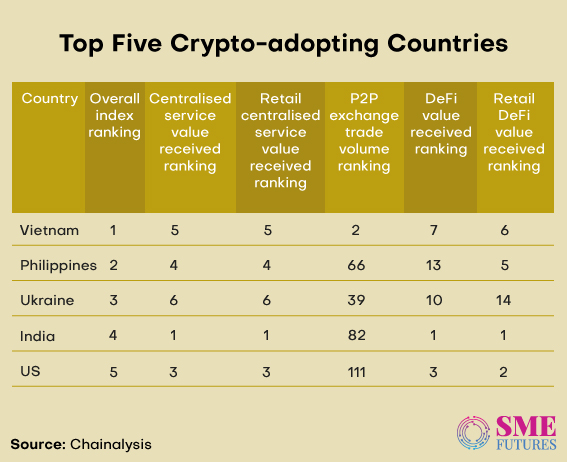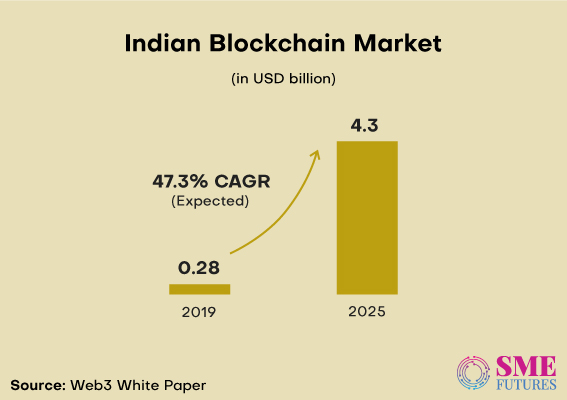In recent years, the world has witnessed the meteoric rise of cryptocurrency as a legitimate form of digital currency. However, India has been slow to adopt this trend, with the government being wary of its potential misuse in criminal activities.
Nonetheless, the country has seen a surge in cryptocurrency investments and trading, leading to a slew of recent developments, including the crypto ban being lifted by the Supreme Court and since then, the crypto market in India has witnessed a significant surge in activity.
According to a report by Chainalysis, a blockchain analytics firm, India ranks 4th among the top five countries in the world with the highest cryptocurrency adoption rates, with over 15 million Indians actively trading in or holding digital assets. Also, the Indian Blockchain market is expected to reach from US$ 0.28 billion in 2019 to US$ 4.3 billion by 2025 at a 47.3 per cent CAGR, according to a white paper.

This implies that despite the government’s stringent regulations, the cryptocurrency market in India is expanding. However, the government has taken another step to bring it into compliance with the law.
The government recently included cryptocurrency in the Prevention of Money Laundering Act (PMLA), stating that the regulations are necessary to prevent money laundering and other criminal activities, and that its users’ privacy will be protected.
Also Watch: Know why crypto is brought under Money laundering law
The move is being welcomed
There has been an excitement in the crypto space since the announcement of the inclusion of cryptocurrency and digital assets under the PMLA and crypto enthusiasts and entrepreneurs are being quite welcoming towards this move by the government.
Also Read: Almost 80% of early-stage startups to increase workforce in 2023: FICCI–Randstad survey
“We see this move as a step towards a well-regulated crypto ecosystem,” says Sumit Gupta, Co-founder of CoinDCX.
“As per the notification, due diligence and enhanced due diligence are now mandated for entities like CoinDCX under the PMLA and the VDA services providers are now effectively categorised as reporting entities. This ensures that only strong and transparent players operate in the industry, and comply,” he adds.
Speaking with SME Futures, Vice President of WazirX, Rajagopal Menon says, “We welcome the new notification regarding anti-money laundering (AML) reporting to the Financial Intelligence Unit (FIU) for crypto assets, which aligns with our existing policies and practices. This is the first of many steps towards regulation and we are committed to complying with all relevant regulations and guidelines.”
Weighing in, Mohammed Roshan, Co-founder & CEO at GoSats, says, “This is a progressive step for the Indian crypto ecosystem. This move will help strengthen the collective efforts of the industry to effectively combat money laundering and other illegal activities.”
The PMLA has been used to address the use of cryptocurrencies for illegal activities. In 2018, the Enforcement Directorate (ED) conducted raids on several cryptocurrency exchanges, alleging that they were involved in money laundering and terrorism financing. The ED also seized cryptocurrency worth millions of dollars in these raids.
Speaking about which, Founder of KoinX, Punit Agarwal says, “The surge of cryptos and VDAs has also led to a surge in problems like money laundering in the space. Because of this, more than Rs. 900 crores were allegedly laundered, which was eventually seized by the PMLA.”

“Because of the presence of bad actors, concerns like the safekeeping of assets and their related financial services could very well be prevented under the ambit of the Prevention of Money Laundering Act (PMLA),” he adds.
Impact on the Indian crypto ecosystem
Many countries around the world have recognised the potential benefits of cryptocurrencies and have put regulatory frameworks in place to govern their use.
Moreover, India, like many other countries around the world, is grappling with the issue of regulating cryptocurrencies. And the PMLA will reshape the crypto economy of the country.
Also Read: India’s tech SME sector revenue to reach $40 bn by FY30: Nasscom
“This means that VDA platforms are now mandated to undertake KYCs and monitor and record all transactions and report to the FIU as and when any suspicious activity is detected,” says Singhal from Coinswitch.
“Such rules are already applicable to banks, financial institutions, and some other entities such as intermediaries like security, markets, real estate, etc. And these have now been extended to cover VDAs as well,” he explains.
Explaining the impact of the PMLA inclusion, Agarwal from KoinX remarks, “Businesses and exchanges now would have to strictly perform and report Know your transactions (KYTs), perform thorough transaction monitoring & reporting, address screening, and report any Suspicious Activity Reports (SARs) or any Suspicious Transaction Reports (STRs).”
Kriti Singh, Chief of Staff of a public policy think tank, The Dialogue, explains that an individual or group who holds about 10 per cent ownership in the client of a ‘reporting entity’ will be seen as the beneficial owner as against the earlier threshold of 25 per cent ownership.
“This means that along with banks and financial institutions, who are ‘reporting entities’, the entities dealing with virtual digital assets will be accorded the same status, which will enable the government to track their transactions, including those that are being carried out outside India,” she adds.
This move can also help to improve the crypto industry’s reputation. Also, more entrepreneurs and investors will get involved, which will lead to more growth and innovation.
Challenges are on their way
The inclusion of cryptocurrencies under the PMLA has also led to concerns among the crypto community regarding privacy and data protection. Many argue that the stringent KYC norms and record-keeping requirements will infringe on the privacy of the users and expose them to the risk of data breaches.
Additionally, due to this, the compliance costs for crypto companies could increase, as they may need to spend on new technology and new processes to comply with the requirements.
Also Read: Indian goods exports easier due to harmonisation of standards: BIS chief
“They could make it more difficult for crypto firms to operate globally. Various nations have distinct AML regulations, and meeting them all can be challenging,” says Menon from WazirX.
Explaining how this could also lead to increased costs for businesses, Agarwal from KoinX says, “This is because they’d have to invest in systems and processes to comply with the regulations. It could also make it more difficult for some users to access cryptocurrency exchanges if they do not meet the KYC requirements.”
The PMLA will also require the cryptocurrency exchanges and the other intermediaries to maintain records of their transactions and report any suspicious transactions to the FIU. This will further lead to a stricter scrutiny of crypto transactions and exchanges – a process that will take place in the due course of time.
However, the government has stated that these regulations are necessary to prevent money laundering and other criminal activities and that the privacy of the users will be protected.
Intention behind the PMLA
Crypto transactions are inherently pseudo-anonymous, making tracking the source and destination of the funds difficult. By placing crypto under the purview of the PMLA, the government is ensuring that companies adhere to strict KYC standards and retain a record of all their transactions, making it easier to identify suspicious behaviour and prevent money laundering.
“The global nature of cryptos makes effective regulation difficult for any single government. Because of this lack of regulation, cryptos could be used by bad actors to shift funds across borders without being detected. By incorporating crypto exchanges under the PMLA, India is taking an important step towards regulating cryptos and limiting their misuse,” says Menon from WazirX.
The goal of this law seems to be to safeguard the interests of the investors and traders in the country – particularly the ones that aren’t very familiar with the ups and downs of the industry.
“This could work out well in the favour of the investors across the country as it contributes to a safer crypto environment and prevents any misuse of the investors’ money,” Agarwal from KoinX points out.
Also Read: ‘Indian goods and services exports set to cross $760 bn in 2022-23’
“The government might give the much-needed clarity on the legal and regulatory environment for cryptos by putting crypto companies under the PMLA,” Menon adds.
This move of the government’s can improve the industry’s overall integrity and make it a safer place for consumers to invest their money in. Hence the future of crypto and VDAs in India seems bright.
How’s the road ahead?
The cryptocurrency market in India has seen significant growth and development in recent years. However, with the lifting of the crypto ban and the inclusion of crypto under the PMLA now, the crypto industry hopes for even faster growth.
“However, the taxation and regulatory battles haven’t been easy for these start-ups. Despite the regulatory uncertainties and challenges, there is a growing interest and demand for cryptocurrencies and blockchain technology in the country,” Punit Agarwal avers.
The future of the crypto start-ups in India is extremely promising. Mohammed Roshan from GoSats believes that with the right regulations and policies in place, India has the potential to be a global hub for crypto and become the ‘Silicon Valley of Crypto’.
“India has an abundance of talented developers, ample capital from venture capital and other investors interested in investing in the Indian growth story, and a vast tech-savvy young population – all of which can contribute to making this a reality,” Roshan further adds.
While Singh from The Dialogue feels that since it is an emerging sector, its regulation has not yet come through because of certain challenges such as money laundering, terror financing, cybersecurity, consumer protection and so on.
“It is pertinent to address these issues and this move is in the right direction towards addressing a few of these concerns and will provide more visibility to the government along with the collective efforts of the industry,” Singh emphasises.
In conclusion, Indian crypto techies believe that while there are concerns over the use of cryptocurrencies for illegal activities, it is important to recognize their potential benefits. Therefore, the proposed bill is a step in the right direction, and it is hoped that it will lead to a more comprehensive regulatory framework for cryptocurrencies in India.











